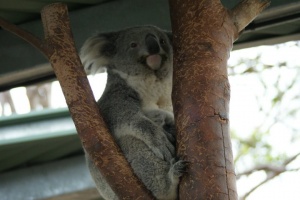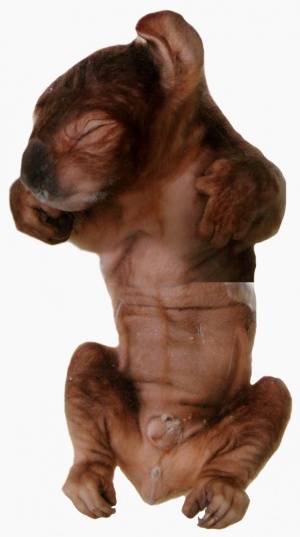Koala Development
| Embryology - 27 Apr 2024 |
|---|
| Google Translate - select your language from the list shown below (this will open a new external page) |
|
العربية | català | 中文 | 中國傳統的 | français | Deutsche | עִברִית | हिंदी | bahasa Indonesia | italiano | 日本語 | 한국어 | မြန်မာ | Pilipino | Polskie | português | ਪੰਜਾਬੀ ਦੇ | Română | русский | Español | Swahili | Svensk | ไทย | Türkçe | اردو | ייִדיש | Tiếng Việt These external translations are automated and may not be accurate. (More? About Translations) |
Introduction
The koala (Phascolarctos cinereus) is an arboreal herbivorous marsupial native to Australia, and the only extant representative of the family Phascolarctidae.
(Greek, phaskolos = "pouch" and arktos = "bear"; Latin, cinereus = "ash-coloured")
| Australian Animal: echidna | kangaroo | koala | platypus | possum | Category:Echidna | Category:Kangaroo | Category:Koala | Category:Platypus | Category:Possum | Category:Marsupial | Category:Monotreme | Development Timetable | K12 | |||||
|
| ||||
Some Recent Findings
|
| More recent papers |
|---|
|
This table allows an automated computer search of the external PubMed database using the listed "Search term" text link.
More? References | Discussion Page | Journal Searches | 2019 References | 2020 References Search term: Koala Embryology | Koala Development |
| Older papers |
|---|
| These papers originally appeared in the Some Recent Findings table, but as that list grew in length have now been shuffled down to this collapsible table.
See also the Discussion Page for other references listed by year and References on this current page.
|
Taxon
Taxonomy ID: 38626
Genbank common name: koala Inherited blast name: marsupials
Rank: species
Genetic code: Translation table 1 (Standard)
Mitochondrial genetic code: Translation table 2 (Vertebrate Mitochondrial)
Lineage ( full ) cellular organisms; Eukaryota; Fungi/Metazoa group; Metazoa; Eumetazoa; Bilateria; Coelomata; Deuterostomia; Chordata; Craniata; Vertebrata; Gnathostomata; Teleostomi; Euteleostomi; Sarcopterygii; Tetrapoda; Amniota; Mammalia; Theria; Metatheria; Diprotodontia; Phascolarctidae; Phascolarctos
Development Overview
- Adults - females reach maturity at 2 to 3 years of age, males at about 3 years of age.[7]
- Joey - a single young produced each year for about 12 years.
- Gestation - approximately 35 days, born under-developed (hairless, blind, and earless). There is a report of extended gestation.[8]
- Birth - joey about 6 mm long crawls into the the mother's downward-facing pouch.
- Pouch Development - joey remain in the pouch for about 6 months attached to one of the two available teats and feeding on milk, complete development.
- Outside of the pouch - joey then begins to explore and to consume small quantities of the mother’s "pap" (thought to come from the mother's cecum) in order to inoculate its gut with the microbes necessary to digest eucalypt leaves.
- Joey will remain with its mother for about another 6 months, riding on her back, and feeding on both milk and eucalypt leaves until weaning is complete at about 12 months of age.
System Development
The marsupial neonate at birth has a variation between the degree of development of different systems.[9]
- well-developed - digestive, respiratory and circulatory system.
- not well-developed - retains fetal excretory system with a fully functional mesonephric kidney and undifferentiated gonads and genitalia.
Oocyte
Ovarian Follicle Development
The following data is from a histological study of ovaries from adult female koalas.[10]
- primordial follicles - have a small primary oocyte surrounded by a few squamous epithelial cells
- primary follicles - have a single layer of cuboidal granulosa cells around the oocyte.
- secondary follicles - have two or more layers of granulosa cells but no antrum
- tertiary follicles (Graafian) - have many layers of granulosa cells surrounding a follicular fluid-filled antrum of variable size.
- oocytes about 140 µm in diameter (range 110–162 µm: n = 5 individuals) surrounded by a zona pellucida (ZP) about 8 µm thick, which is twice as thick as most other marsupial species.
Marsupial eggs are enclosed by a series of layers:[11]
- zona pellucida, three zona proteins (ZPA, ZPB, ZPC)
- an additional extracellular matrix coat that lines the zona pellucida also occurs in some species.
- mucoid coat
- outer shell coat.
- Links: oocyte | zona pellucida
Spermatozoa
The spermatozoa head is hook-shaped with the most of the acrosomal contents lying within a nuclear concavity. Spermatozoa nuclei show a range of morphologies and a tendency to swell after cryopreservation procedures.[12]
- Links: spermatozoa
References
- ↑ Moros-Nicolás C, Chevret P, Izquierdo-Rico MJ, Holt WV, Esteban-Díaz D, López-Béjar M, Martínez-Nevado E, Nilsson MA, Ballesta J & Avilés M. (2017). Composition of marsupial zona pellucida: a molecular and phylogenetic approach. Reprod. Fertil. Dev. , , . PMID: 29162213 DOI.
- ↑ Morris KM, O'Meally D, Zaw T, Song X, Gillett A, Molloy MP, Polkinghorne A & Belov K. (2016). Characterisation of the immune compounds in koala milk using a combined transcriptomic and proteomic approach. Sci Rep , 6, 35011. PMID: 27713568 DOI.
- ↑ Johnston SD & Holt WV. (2014). The koala (Phascolarctos cinereus): a case study in the development of reproductive technology in a marsupial. Adv. Exp. Med. Biol. , 753, 171-203. PMID: 25091911 DOI.
- ↑ Keyte AL & Smith KK. (2010). Developmental origins of precocial forelimbs in marsupial neonates. Development , 137, 4283-94. PMID: 21098569 DOI.
- ↑ Hynes EF, Handasyde KA, Shaw G & Renfree MB. (2010). Levonorgestrel, not etonogestrel, provides contraception in free-ranging koalas. Reprod. Fertil. Dev. , 22, 913-9. PMID: 20591325 DOI.
- ↑ Rodger JC, Paris DB, Czarny NA, Harris MS, Molinia FC, Taggart DA, Allen CD & Johnston SD. (2009). Artificial insemination in marsupials. Theriogenology , 71, 176-89. PMID: 18950846 DOI.
- ↑ Esson C & Armati PJ. (1998). Development of the male urogenital system of the koala phascolarctos cinereus. Anat. Embryol. , 197, 217-27. PMID: 9543340
- ↑ Gifford A, Fry G, Houlden BA, Fletcher TP & Deane EM. (2002). Gestational length in the koala, Phascolarctos cinereus. Anim. Reprod. Sci. , 70, 261-6. PMID: 11943495
- ↑ Renfree MB, Pask AJ & Shaw G. (2001). Sex down under: the differentiation of sexual dimorphisms during marsupial development. Reprod. Fertil. Dev. , 13, 679-90. PMID: 11999321
- ↑ Chapman JA, Leigh CM & Breed WG. (2006). The zona pellucida of the koala (Phascolarctos cinereus): its morphogenesis and thickness. J. Anat. , 209, 393-400. PMID: 16928207 DOI.
- ↑ Selwood L. (2000). Marsupial egg and embryo coats. Cells Tissues Organs (Print) , 166, 208-19. PMID: 10729728 DOI.
- ↑ Johnston SD, López-Fernández C, Gosálbez A, Zee Y, Holt WV, Allen C & Gosálvez J. (2007). The relationship between sperm morphology and chromatin integrity in the koala (Phascolarctos cinereus) as assessed by the Sperm Chromatin Dispersion test (SCDt). J. Androl. , 28, 891-9. PMID: 17609294 DOI.
Reviews
Johnston SD & Holt WV. (2014). The koala (Phascolarctos cinereus): a case study in the development of reproductive technology in a marsupial. Adv. Exp. Med. Biol. , 753, 171-203. PMID: 25091911 DOI.
Renfree MB. (1993). Diapause, pregnancy, and parturition in Australian marsupials. J. Exp. Zool. , 266, 450-62. PMID: 8371091 DOI.
Articles
Chapman JA, Leigh CM & Breed WG. (2006). The zona pellucida of the koala (Phascolarctos cinereus): its morphogenesis and thickness. J. Anat. , 209, 393-400. PMID: 16928207 DOI.
Gifford A, Fry G, Houlden BA, Fletcher TP & Deane EM. (2002). Gestational length in the koala, Phascolarctos cinereus. Anim. Reprod. Sci. , 70, 261-6. PMID: 11943495
Grand TI & Barboza PS. (2001). Anatomy and development of the koala, Phascolarctos cinereus: an evolutionary perspective on the superfamily Vombatoidea. Anat. Embryol. , 203, 211-23. PMID: 11303907
Books
Search PubMed
Note searches using the term "Koala" will also find papers that refer to the KOALA Birth Cohort Study, a European study not related to the Australian animal.
Search PubMed: Phascolarctos cinereus | Koala development | marsupial development
External Links
External Links Notice - The dynamic nature of the internet may mean that some of these listed links may no longer function. If the link no longer works search the web with the link text or name. Links to any external commercial sites are provided for information purposes only and should never be considered an endorsement. UNSW Embryology is provided as an educational resource with no clinical information or commercial affiliation.
Glossary Links
- Glossary: A | B | C | D | E | F | G | H | I | J | K | L | M | N | O | P | Q | R | S | T | U | V | W | X | Y | Z | Numbers | Symbols | Term Link
Cite this page: Hill, M.A. (2024, April 27) Embryology Koala Development. Retrieved from https://embryology.med.unsw.edu.au/embryology/index.php/Koala_Development
- © Dr Mark Hill 2024, UNSW Embryology ISBN: 978 0 7334 2609 4 - UNSW CRICOS Provider Code No. 00098G


